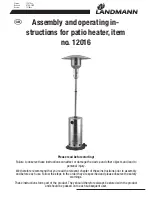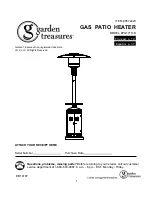
4
2
. Preparation of installation area
2
.1
Positioning the unit
The water heater should be fitted level on a hard surface with sufficient load strength to take the full weight of the cylinder
(see
technical data
table page 1
1
). There are no limitations regarding the fitting distance from walls etc., but it is strongly
recommended to ensure easy access to all pipe fittings etc. The Temperature and Pressure relief valve and immersion
heater are positioned at 90° apart. The
Delta HP VIP
cylinder must be positioned to ensure that the tundish is visible and
there is easy access to the thermostat and to remove the immersion heater if required.
2
.2 Protection from frost
If the water heater is in danger of being exposed to frost while not operating under electric power, the unit must be drained
to avoid damage. Make sure the electric power is turned off before draining, otherwise the heating elements can be
damaged and the warranty is void. Draining instructions, see “Draining ” on page
5
.
3
. Pipe Connecti
ons
3
.1 Cold water supply
3.1.2
To obtain the best performance from your OSO unvented system it is advisable to feed the unit with an
uninterrupted supply
.
3.1.3
Before connecting to the multibloc, flush the cold supply pipework of all flux and debris.
3
.1.4
Locate the water heater in a suitable position to facilitate the installation of the cold water supply, discharge fittings
and pipework. Also take into account access to the immersion heater.
3
.1.5
Fit the combined male elbow drain cock to cold supply point (
12
), so that the compression fitting is vertical.
3.1.6
Fit the length of copper tube 22mm specified in Table
1
to the cold feed elbow (see
3.1.5
above) to include a Tee
piece if a secondary return is required
.
3.1.7
Fit the
Multibloc
(
3
) to the top of the copper tube (see
3.1.6
above).
3
.1.8
Connect 15mm copper tube from the expansion relief valve (
4
) and also from the T & P valve
(5) and join together in
a Tee as shown on page
3.
3
.1.9
Fit the tundish (
6
) to the bottom connection of this tee.
3
.1.10
Connect the cold supply to the
multibloc
(
3
).
3
.1.11
Fit the expansion vessel to the wall close to the water heater using the enclosed mounting bracket. Connect
the expansion vessel to the
multibloc
, as shown on page
3
.
3
.2 Hot water supply
Connect the hot water supply pipe to the outlet (
11
). Ensure connection is water tight
.
3
.
3
Balanced cold water supply (optional).
If no balanced cold supply is required, tighten the supplied blanking cap. If a balanced mains pressure cold water supply is
required to a shower or bidet (over rim type only, ascending spray type requires type AA,AB or AD air gap), remove
blanking cap and connect to the shower or bidet cold supply on the
multibloc
valve (
3
).
(Major shower manufacturers advise fitting a mini expansion vessel in the balanced cold supply pipework to
accommodate
thermal expansion and prevent tightening of shower controls) Using the balanced cold connection to feed bath taps can
reduce the flow available to the unvented cylinder.
3
.4 Secondary return
(optional)
Connect secondary return if required to the Tee piece in the cold feed tube see
diagram on
page
1
2
3
.
5
Discharge pip
e
Connect the tundish outlet to the discharge pipe. Install the Tundish in a vertical position within a maximum of 600 mm
from the Temperature and Pressure Relief Valve drain connection. Ensure the expansion relief pipework discharges
through the tundish. Tundish pipework must be 22 mm with a minimum vertical length of 300 mm below tundish. Maximum
permitted length of 22 mm pipework is 9 m.
Each bend or elbow is equivalent to 0.8 m of pipework. All
pipework must have
continuous
fall and discharge in a safe, visible position. If any doubt, refer to Building Regulation G3.
Discharge pipe must be dedicated to the cylinder and must not be used for any other purpose.
Содержание DGC 200
Страница 11: ......


































